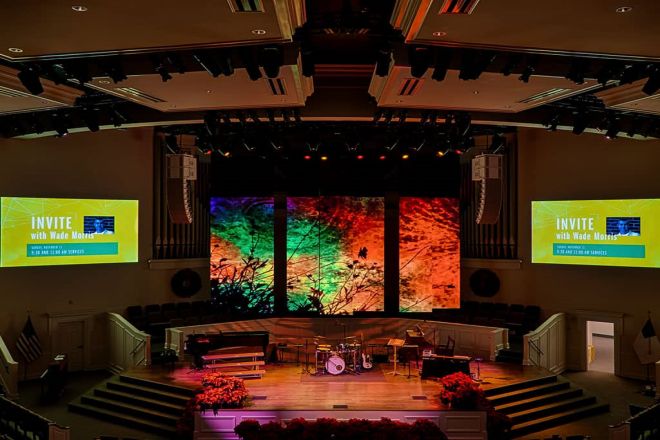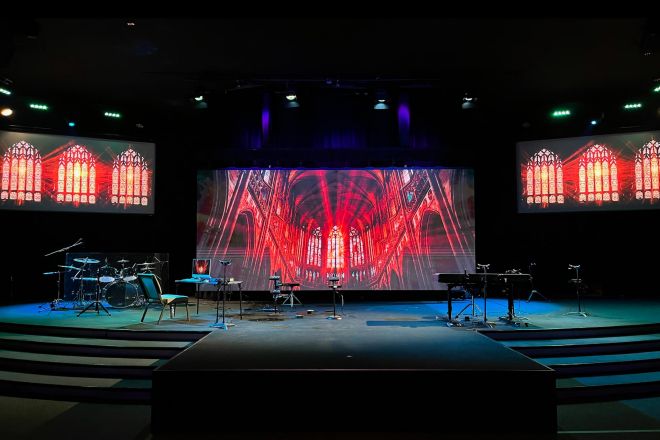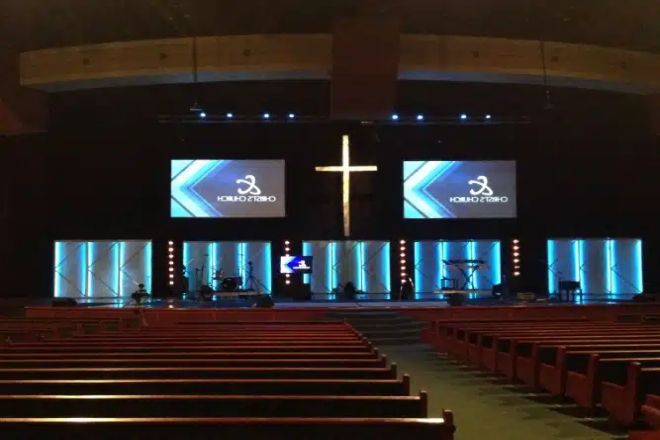مقدمة

In the torrent of the times, the church, as a symbol of the spiritual home of mankind, has always carried the transmission of faith and the comfort of the soul. With the rapid development of science and technology, the ancient كنيسة architecture began to collide and merge with modern scientific and technological elements, blooming with unprecedented brilliance.
As an outstanding representative of modern technology, the شاشة عرض LED has added unlimited possibilities to the church’s worship ceremony and community activities with its high definition, high brightness, and flexible display methods.
1. Evaluation and diagnosis of existing equipment
1). Performance inspection: comprehensive and detailed technical review
In the first step to improve the picture quality of the church LED display screen, we need to conduct a comprehensive and in-depth performance inspection of the existing display screen. This process is not only about the direct evaluation of the hardware level but also a comprehensive consideration of the display effect.
- Resolution verification:
First, we will use professional test patterns and software to verify whether the actual resolution of the display screen is consistent with the design specifications. High resolution is the basis for ensuring delicate pictures and clear text. Any deviation may affect the final display effect.
- Brightness and contrast test:
A photometer and contrast tester will be used to measure the brightness and contrast performance of the display screen under different lighting conditions. This helps us understand the visibility and layering of the screen in different environments.
- Color saturation and accuracy evaluation:
Color is an important part of the visual experience. We will use a color analyzer to accurately measure the color saturation, color gamut coverage, and color accuracy of the display. This helps to identify whether there are color deviations or distortion issues.
- Refresh rate and response time detection:
For dynamic images, refresh rate and response time are equally important. We will evaluate the dynamic display effect of the display by playing high-speed motion images and observing whether there is smearing or blurring.
2). Problem identification: meticulous troubleshooting
After completing the performance check, we will carefully analyze the display problems based on the collected data. These problems may directly affect the picture quality and reduce the audience’s visual experience.
- Uneven brightness problem:
By observing the brightness difference in each area of the screen, identify whether there is uneven brightness. This may be caused by aging of the backlight module, dust accumulation, or uneven installation.
- Color distortion analysis:
Compare the test pattern with the actual display effect to identify color deviation or distortion problems. This may be related to improper color management settings, aging of the display, or environmental factors such as magnetic field interference.
- Pixel fault detection:
Carefully check every pixel on the screen to identify whether there are dead spots, bright spots, or dark spots. These fault points will directly affect the integrity and clarity of the picture.
3). Cause analysis: In-depth analysis, tracing the source
For the identified problems, we will conduct an in-depth cause analysis in order to develop effective solutions.
- Hardware aging discussion:
For problems such as uneven brightness and color distortion, we first consider whether it is caused by hardware aging. This includes the life decay of key components such as backlight modules, driver ICs, and color filters.
- Improper setting review:
Check whether the brightness, contrast, color management, and other settings of the display are reasonable. Improper settings may lead to a decline in picture quality and affect the audience’s visual experience.
- Environmental interference analysis:
Consider the impact of environmental factors on the picture quality of the display. For example, magnetic field interference may cause color distortion, while temperature changes and excessive humidity may affect the stability and life of the display.
2. Targeted adjustment and optimization

1). Brightness and color correction:
1.1). Accurate adjustment to restore true colors
For the problems of uneven brightness and color distortion, we will take a series of professional measures to perform detailed corrections to ensure that the display presents the best picture effect.
- Professional equipment application:
First, professional photometers, color analyzers, and other equipment should be used to measure the brightness and color of the display accurately. These devices can capture subtle differences that are difficult for the human eye to detect, providing accurate data support for subsequent correction work.
- Brightness uniformity adjustment:
To address the problem of uneven brightness, we will fine-tune the brightness of each area of the screen by adjusting the brightness distribution of the backlight module or using professional brightness correction software. This process may require multiple iterations until the brightness of the entire screen is uniform and consistent.
- Color precision correction:
The problem of color distortion needs to be corrected through a color management system. We will adjust the color parameters of the display, such as color temperature, white balance, color saturation, etc., based on the measurement results to restore more realistic and natural colors.
At the same time, the lighting environment inside the church will also be considered to ensure that the color performance of the display remains stable under different lighting conditions.
1.2). Pixel repair: Restore details to ensure the integrity of the picture
Pixel failure is a common problem that affects the integrity and clarity of the display. In order to restore the display to its perfect state, we will use professional pixel repair technology or equipment for processing.
- Fault point location:
First, use professional testing equipment to conduct a comprehensive scan of the display screen to accurately locate the faulty pixel. These devices can quickly identify different types of faults, such as dead spots, bright spots, or dark spots.
- Repair technology selection:
Select the appropriate repair technology according to the specific situation of the fault point. For minor fault points, you can try to use software repair methods to cover up the fault point by adjusting the brightness or color of the surrounding pixels. For more serious fault points, physical repair methods may be required, such as replacing the driver IC of the faulty pixel or the entire pixel module.
- Effect verification:
After the repair is completed, use the detection equipment to verify the display screen again to ensure that the fault point has been completely repaired and the picture is restored to be complete and clear.
1.3). Software optimization: Custom settings to improve display effects
In addition to hardware-level adjustments, software optimization is also an important means of improving the image quality of the display screen. We will conduct a comprehensive inspection and update the playback software to ensure that its version is compatible with the hardware, as well as customize the settings according to the church’s actual situation.
- Software version update:
First, check the latest version information of the playback software to ensure that the software is up to date. New versions of software usually contain performance improvements, new features, and bug fixes, which can improve display effects and user experience.
- Playback mode adjustment:
Adjust the playback mode of the playback software according to the actual needs and usage scenarios of the church. For example, in worship ceremonies, you may need to set a loop playback mode and adjust the playback speed and transition effects; in festival celebrations, you may need to set specific animation effects and background music, etc.
- Resolution adaptation:
Make sure that the resolution of the playback software matches the resolution of the display. High resolution can provide clearer and more delicate picture effects, but it is also necessary to consider the balance between hardware performance and playback smoothness. We will choose the appropriate resolution setting based on the display’s actual performance and usage requirements.
3. Content production and adaptation
1). HD material preparation: Careful selection to ensure excellent picture quality
In the first step of content production, we strictly control the quality of the material to ensure that all content used for display screens is in HD format. This is not only the key to improving picture clarity but also the basis for showing the professional and solemn atmosphere of the church.
- HD standards:
We follow industry HD standards to ensure that the resolution of materials such as videos and pictures is at least the recommended resolution of the display, or even higher. This can effectively avoid blurring of the material during playback due to insufficient resolution.
- Material cropping and scaling:
According to the actual resolution and ratio of the display screen, we will perform fine cropping and scaling of the material. In this process, we focus on maintaining the original ratio and key information of the material, while ensuring that it can fill the entire screen when presented on the display screen to avoid black edges or stretching deformation.
- فحص الجودة:
After the material preparation is completed, we will also conduct a comprehensive quality inspection to ensure that each frame is clear and noise-free, laying a solid foundation for the subsequent display effect.
2). Professional design: Ingenious and creating a church atmosphere
In order to design display content that matches the atmosphere of the church, we hired professional designers or teams who have rich design experience and keen aesthetic vision.
- Style positioning:
The designer will first communicate with the church to understand the church’s decoration style, theme, and the message it wants to convey. Based on this information, the designer will determine an overall design style, such as classical, modern, simple, etc., to ensure that the display content is in harmony with the church environment.
- Color matching and composition:
In color matching, the designer will pay attention to the harmony and unity of colors, and avoid color combinations that are too glaring or abrupt. At the same time, through clever composition and layout, key information is highlighted, guiding the audience’s line of sight and enhancing the visual impact.
- Creative elements integration:
In order to enhance the attractiveness and uniqueness of the display content, designers will also incorporate some creative elements, such as customized patterns, text effects, or dynamic elements. These elements can not only enrich the expressiveness of the picture but also better convey the information and emotions that the church wants to express.
3). Dynamic effect optimization: smooth and natural, enhancing the visual experience.
For display content that requires dynamic effects, we use professional animation design software for production and optimization.
- Animation design:
According to the theme and style of the display content, we design smooth and natural animation effects. These animation effects need to be closely coordinated with background music, lighting, and other elements to create a harmonious and unified visual atmosphere.
- Speed adjustment:
We accurately adjust the animation speed according to the refresh rate and response time of the display. Ensure that the animation can smoothly display every detail during playback and avoid stuttering or smearing.
- Preview and adjustment:
Once the animation is completed, we will preview and adjust it several times. By constantly observing the actual performance of the animation on the display, we discovered and corrected possible problems and deficiencies to ensure that the final display effect could reach its best state.
4. Daily maintenance and care

In order to ensure the long-term stable operation of the church LED display and continue to provide high-quality visual effects, daily maintenance and care are essential. The following are several key measures we will take:
1). Regular cleaning: Keep the picture clear and extend the service life
Cleaning cycle:
We will formulate a suitable cleaning cycle based on the frequency of use and environmental conditions of the church. It is generally recommended to clean at least once a month or clean it in time when obvious dust and dirt are found on the surface of the display.
Professional tools and materials:
Use a soft dry cloth or a special display cleaning cloth, with an appropriate amount of clean water or a special detergent (avoid using detergents containing alcohol or chemical solvents), and gently wipe the surface of the display. Avoid using hard or sharp objects to directly contact the screen to prevent scratches.
Comprehensive inspection:
During the cleaning process, in addition to removing dust and dirt, the frame, heat dissipation holes, and other parts of the display will also be fully inspected to ensure that there is no debris blocking or damage.
2). Environmental monitoring: optimize display effects and protect hardware safety
- Light environment:
Changes in the light environment in the church may affect the display effect of the display. We will pay close attention to light changes and adjust the brightness and color temperature settings of the display in time to ensure the best visual effect under different light conditions.
- Temperature control:
The operating temperature of the display has an important impact on its performance and life. We will ensure that the temperature in the church remains within the recommended operating range of the display to avoid damage to the display due to overheating or overcooling.
- Humidity and dust prevention:
At the same time, we will also pay attention to the humidity and dust prevention in the church. Excessive humidity may cause moisture damage to the internal components of the display, while dust accumulation will affect heat dissipation and picture quality. Therefore, we will take measures to keep the church clean and maintain a suitable humidity level.
3). Fault prevention: early intervention to reduce downtime
- التفتيش المنتظم:
Establish a regular inspection system to conduct a comprehensive inspection of key parts of the display, such as hardware connections, power supply, and control system. Through regular inspections, potential problems can be discovered and dealt with in a timely manner to prevent small problems from turning into major failures.
- Fault warning mechanism:
Use intelligent monitoring technology to monitor the operating status of the display in real time. Once an abnormal situation is found (such as abnormal brightness, color distortion, pixel failure, etc.), the system will immediately issue a warning signal and automatically record relevant information for subsequent analysis and processing.
- الصيانة المهنية:
For problems that cannot be solved through daily maintenance, we will contact a professional maintenance team in time to handle them. Ensure that the maintenance process is standardized and efficient, and reduce the impact on the normal activities of the church.
خاتمة
With the wonderful presentation of the theme of “horizontal straight rise” on the church LED display, we not only witnessed the perfect integration of technology and religious culture but also deeply felt the power of faith and the miracle of life. This visual feast not only allows believers to receive spiritual baptism in the solemn ceremony but also injects new vitality and hope into the church.
أخيرًا، إذا كنت تريد معرفة المزيد عن شاشات LED، يرجى الحصول على اتصال معنا.
